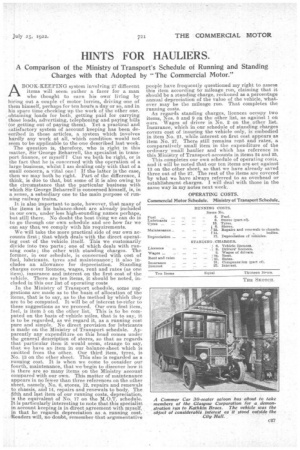HINTS FOR HAULIERS.
Page 9

If you've noticed an error in this article please click here to report it so we can fix it.
A Comparison of the Ministry of Transport's Schedule of Running and Standing Charges with that Adopted by "The Commercial Motor."
ABOOK-KEEPING system involving 27 different items will seem rather a facer for a man who thought to earn his awn living by hiring out a couple of motor lorries, driving one of them himself, perhaps for ten houir's a day or so and in
his spare time checking up the work of the other one
obtaining loads for both, getting paid for .carrying those loads, advertising, telephoning and paying bills (or getting out of paying them). -Yet a practical and
natisfactory system of account keeping has been described in these articles, a system which involves hardly any work at all, which condition would not
seem tobe applicable to the one described last week. The question is, therefore, who is right in this matter, Sir-George Beharrell, the specialist in trans port finance, or myself ? Can we both be right, or is the fact that he is concerned with the operation of a large business, whilst I am dealing only with that of a small concern, a vital one? If the latter is the case, then we may both be right. Part of the difference, I think, is due to that, but some of it is also owing to the circumstance that the particular business with which Sir George Beharrelt is concerned himself, is, in a sense, a. subsidiary one to the main purpose of running railway trains.
It is also important to note, however, that many of the items in his balance-sheet are already included in our own, under less high-sounding names perhaps, but still there. No doubt the best thing we can do is to go through our own schedule and see how far we can say that we comply with his requirements.
We will take the more practical side of our own accounts first ; that which deals with the direct operating cost of the vehicle itself. This we customarily divide into two parts; one of which deals with running costs ; the other with standing charges. The former, in our schedule, is concerned with cost of fuel, lubricant& tyres and maintenance ; it also includes an allowance for depreciation. Standing charges cover licences, wages, rent and rates (as one item), insurance and interest on the first cost of the vehicle. There are ten items, it should be noted, included in this our list of operating costs
In the Ministry of Transport schedule, some suggestions are made as to the basis of allocation of the items, that is to say, as to the method by which they are to be computed. It will be of interest to-refer to these suggestions as we proceed. Our own first item, fuel, is item 5 on the other list. This is to be computed on the basis ofvehicle miles, that is to say, it is to be regarded, as w6 regard it, as a running cost pure and simple. No direct provision for lubricants is made on the Ministry of Transport schedule. Apparently any expenditure on this head comes under the general description of stores, so that as regards that particular item it would seem, strange to say, that we have an item in our balance-sheet which is omitted from the other. Our third item, tyres, is No. 13 on the other sheet. This also is regarded as a running cost. It is when we come to consider our fourth, maintenance, that we begin to discover how it is there are so many items on the Ministry account compared with our awn. This matter of maintenance appears in no fewer than three references on the other sheet, namely, No. 6, stores, 12, repairs and renewals to chassis, and 14, repairs and renewals to body. The fifth and last item of our running costs, depreciation, is the equivalent of No 17 on the M.O.T. schedule. It is particularly interesting to note that this specialist in account keeping is in direct agreement with myself, in that he regards depreciation as a running cost. Readers will, no doubt, .reinernber that argumentative people have frequently questioned my right to assess this item according tomileage run, claiming that it should be a standing charge, reckoned as a percentage annual depreciation of the value of the vehicle, whatever may be the mileage run. That completes the running costs. As regards standing charges, licences occupy two items, Nos. 8 and 9 on the other list, as against 1 on ours. " Wages of driver is No. 2 on the other list. Insurance, which in our schedule of standing charges covers cost of insuring the vehicle only, is embodied in item No. 21, while interest on first cost appears. as item .No. 27. There still remains rent and rates, a comparatively small item in the expenditure of the ordinary small hatilier and which has reference in. this Ministry of Transport accounts in items 24 and 25. . This completes our awn schedule of operating costs, aud it will be noted that our ten items are set against 13 on the other sheet, 80 that we have already saved three out of the 27. The rest of the items are covered by what we have always referred to as overhead or establishment charges. I will deal with those in the same way in my notes next week.






























